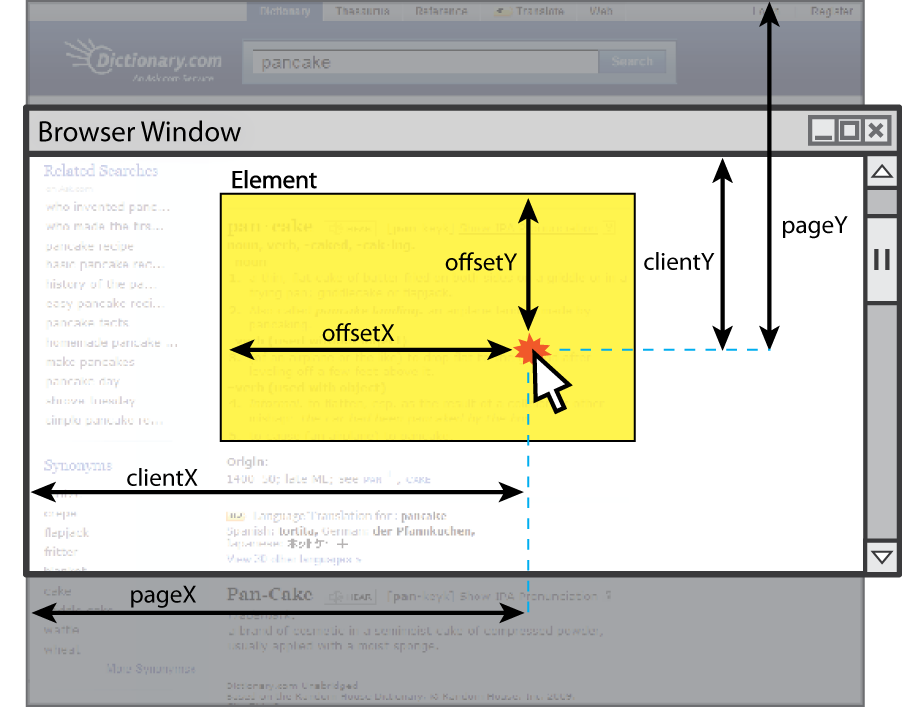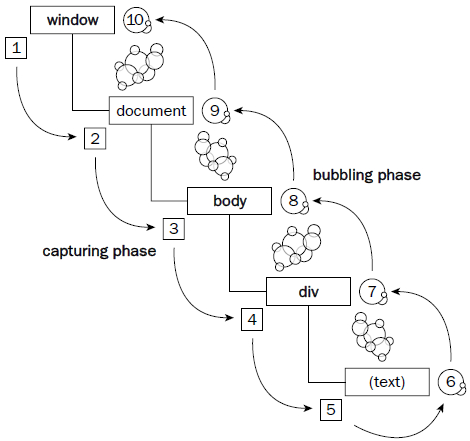CSE 190M Web Programming
Lecture 20: Events
Reading: Chapter 11
Except where otherwise noted, the contents of this document are Copyright 2012 Marty Stepp, Jessica Miller, Victoria Kirst and Roy McElmurry IV. All rights reserved. Any redistribution, reproduction, transmission, or storage of part or all of the contents in any form is prohibited without the author's expressed written permission.
11.1: Event-Handling
-
11.1: Event-Handling
- 11.1.1 The Event Object
- 11.1.2 Mouse Events
- 11.1.3 Keyboard and Text Events
- 11.1.4 Form Events
- 11.1.5 Page Events
- 11.1.6 Timer Events
- 11.2: Case Study: Multiplication Quiz
JavaScript events
abort
|
blur
|
change
|
click
|
dblclick
|
error
|
focus
|
keydown
|
keypress
|
keyup
|
load
|
mousedown
|
mousemove
|
mouseout
|
mouseover
|
mouseup
|
reset
|
resize
|
select
|
submit
|
unload
|
-
the
clickevent (onclick) is just one of many events that can be handled -
problem: events are tricky and have incompatibilities across browsers
- reasons: fuzzy W3C event specs; IE disobeying web standards; etc.
- solution: jQuery includes many event-related features and fixes
Attaching event handlers the jQuery way
element.onevent = function; element.event(function);
// call the playNewGame function when the Play button is clicked $("#play").click(playNewGame); function playNewGame(evt) { // respond to the click event }
-
to use jQuery's event features, you must pass the handler using the jQuery object's
eventmethod - handlers must be attached this way for jQuery's event features to work
-
you can trigger the event manually by calling the same function with no parameters
$("#play").click();
Attaching many event handlers
You often need to attach an event handler to a group of elements.
- With the DOM
var btns = document.querySelectorAll("#game > button.control"); for (var i = 0; i < gameButtons.length; i++) { btns[i].observe("click", gameButtonClick); } function gameButtonClick(evt) { ... } - With jQuery
$("#game > button.control").click(gameButtonClick); function gameButtonClick(evt) { ... } - Why is no loop required?
Exercise: hover bounce
We will elaborate on the bounce.html example.
-
Add code so that when we
mouseoveranimgit'ssrcchanges to dai_gurren.jpg -
If we mouse over the
#squareelement, change it'sbackground-colorinstead.
Custom DOM events
- Events can be attached to elements in a more generic way using the
addEventListenerDOM method.document.getElementById("myid").addEventListener("click", function); - You can create your own event object and then trigger that event on an element.
var evt = document.createEvent("click"); evt.initEvent("click", true, true); document.getElementById("myid").dispatchEvent("click"); - You don't have to use "click", you can use whatever you want in your custom event. You could create a "boom" event, the meaning of which is for you to decide.
Custom jQuery events
- Generic jQuery event registration
$("#myid").on("event", handler); - Trigger an event on a jQuery object
$("#myid").trigger("event");var evt = $.Event("event"); // do stuff with evt to make it special $("#myid").trigger(evt);
The jQuery event object
function handler(event) {
// an event handler function ...
}
- Event handlers can accept an optional parameter to represent the event that is occurring. Event objects have the following properties / methods:
| method / property name | description |
|---|---|
type |
what kind of event, such as "click" or "mousedown" |
target |
the element on which the event handler was registered |
preventDefault() |
prevents browser from performing its usual action in response to the event |
stopPropagation() |
prevents the event from bubbling up further |
stopImmediatePropagation() |
prevents the event from bubbling and prevents any other handlers from being executed |
Specific events
jQuery supports and standardizes all of these, though some events do not have dedicated event functions
- 11.1.1 The Event Object
- 11.1.2 Mouse Events
- 11.1.3 Keyboard and Text Events
- 11.1.4 Form Events
- 11.1.5 Page Events
Mouse events
click
|
user presses/releases mouse button on the element |
dblclick
|
user presses/releases mouse button twice on the element |
mousedown
|
user presses down mouse button on the element |
mouseup
|
user releases mouse button on the element |
mouseover
|
mouse cursor enters the element's box |
mouseout
|
mouse cursor exits the element's box |
mousemove
|
mouse cursor moves around within the element's box |
Mouse event objects
The event passed to a mouse handler has these properties:

| property/method | description |
|---|---|
clientX, clientY
|
coordinates in browser window |
screenX, screenY
|
coordinates in screen |
offsetX, offsetY
|
coordinates in element (non-standard) |
pageX, pageY
|
coordinates in entire web page |
which
|
which mouse button was clicked |
Mouse event example
<pre id="target">Move the mouse over me!</pre>
window.onload = function() {
$("#target").mouseover(showCoords);
};
function showCoords(event) {
$("#target").html(
"page : (" + event.pageX + ", " + event.pageY + ")\n"
+ "screen : (" + event.screenX + ", " + event.screenY + ")\n"
+ "client : (" + event.clientX + ", " + event.clientY + ")"
);
}
Move the mouse over me!
The keyword this
this.fieldName // access field this.fieldName = value; // modify field this.methodName(parameters); // call method
- all JavaScript code actually runs inside of an object
-
by default, code runs in the global
windowobject (sothis===window)-
all global variables and functions you declare become part of
window
-
all global variables and functions you declare become part of
-
the
thiskeyword refers to the current object
Event handler binding
window.onload = function() {
$("textbox").observe("mouseout", booyah); // bound to text box here
$("submit").observe("click", booyah); // bound to submit button here
};
function booyah() { // booyah knows what object it was called on
this.value = "booyah";
}
- event handlers attached unobtrusively are bound to the element
- inside the handler, that element becomes
this(rather than thewindow)
Fixing redundant code with this
<fieldset> <label><input type="radio" name="ducks" value="Huey" /> Huey</label> <label><input type="radio" name="ducks" value="Dewey" /> Dewey</label> <label><input type="radio" name="ducks" value="Louie" /> Louie</label> </fieldset>
$(":radio").click(processDucks);
function processDucks() {
if ($("huey").checked) {
alert("Huey is checked!");
} else if ($("dewey").checked) {
alert("Dewey is checked!");
} else {
alert("Louie is checked!");
}
alert(this.value + " is checked!");
}
- if the same function is assigned to multiple elements, each gets its own bound copy
Page/window events
| name | description |
|---|---|
load,
unload
|
the browser loads/exits the page |
resize
|
the browser window is resized |
error
|
an error occurs when loading a document or an image |
contextmenu
|
the user right-clicks to pop up a context menu |
-
The above can be handled on the
windowobject.
$(window).on('contextmenu', function);
Keyboard/text events
| name | description |
|---|---|
keydown
|
user presses a key while this element has keyboard focus |
keyup
|
user releases a key while this element has keyboard focus |
keypress
|
user presses and releases a key while this element has keyboard focus |
focus
|
this element gains keyboard focus |
blur
|
this element loses keyboard focus |
select
|
this element's text is selected or deselected) |
- focus: the attention of the user's keyboard (given to one element at a time)
Key event objects
| property name | description |
|---|---|
which
|
ASCII integer value of key that was pressed (convert to char with String.fromCharCode)
|
altKey, ctrlKey, shiftKey
|
true if Alt/Ctrl/Shift key is being held
|
-
issue: if the event you attach your listener to doesn't have the focus, you won't hear the event
- possible solution: attach key listener to entire page body, outer element, etc.
Form events
| event name | description |
|---|---|
submit
|
form is being submitted |
reset
|
form is being reset |
change
|
the text or state of a form control has changed |
Stopping an event's browser behavior
<form id="exampleform" action="http://foo.com/foo.php">...</form>
$(function() {
$("#exampleform").submit(checkData);
});
function checkData(event) {
if ($("#city").val() == "" || $("#state").val().length != 2) {
alert("Error, invalid city/state."); // show error message
event.preventDefault();
}
}
-
to abort a form submit or another event's default browser behavior, call jQuery's
preventDefault()method on the event
Which element gets the event
<body> <div> <p> Events are <em>crazy</em>! </p> </div> </body>
$(function() {
$("body, div, p, em").click(hello);
});
function hello() {
alert("You clicked on the " + $(this).attr("tag"));
}
What happens when I click on the span? Which element will get the event?
Answer: All of them!
Event bubbling

<body> <div> <p> Events are <em>crazy</em>! </p> </div> </body>
- Clicking the span is actually a click on every element in this page.
- Therefore it was decided that all of the handlers should be executed.
- The events bubble from the bottom of the DOM tree to the top.
- The opposite model (top to bottom) is called capturing and is not widely used.
Bubbling example
<body> <div> <p> Events are <em>crazy</em>! </p> </div> </body>
$(function() {
$("body, div, p, em").click(hello);
});
function hello() {
alert("You clicked on the " + this.nodeName);
}
Stopping an event from bubbling
Use the stopPropagation()
method of the jQuery event to stop it form bubbling up.
<body> <div> <p> Events are <em>crazy</em>! </p> </div> </body>
$(function() {
$("body, div, p, em").click(hello);
});
function hello(evt) {
alert("You clicked on the " + this.nodeName);
evt.stopPropagation();
}
Multiple handlers
<body> <div> <p> Events are <em>crazy</em>! </p> </div> <p>Another paragraph!</p> </body>
$(function() {
$("body, div, p, em").click(hello);
$("div > p").click(anotherHandler);
});
function hello() {
alert("You clicked on the " + this.nodeName);
}
function anotherHandler() {
alert("You clicked on the inner P tag");
}
What happens when the first p tag is clicked?
Runnable example
Stopping an event right now
function anotherHandler(evt) {
alert("You clicked on the inner P tag");
evt.stopImmediatePropagation();
}
- Use
stopImmediatePropagation()to prevent any further handlers from being executed. - Handlers of the same kind on the same element are otherwise executed in the order in which they were bound.
stopImmediatePropogation() example
$("div a").click(function() {
// Do something
});
$("div a").click(function(evt) {
// Do something else
evt.stopImmediatePropagation();
});
$("div a").click(function() {
// THIS NEVER FIRES
});
$("div").click(function() {
// THIS NEVER FIRES
});
- Only the first two handlers will ever run when the anchor tag is clicked.
jQuery handler return value
- jQuery does something special if you return false in your event handler
- prevents the default browser action, eg
evt.preventDefault() - stops the event from bubbling, eg
evt.stopPropagation()
- prevents the default browser action, eg
<form id="exampleform"> ... <button>Done</button> </form>
$(function() {
$("#exampleform").submit(cleanUpData);
$("button").click(checkData);
});
function checkData() {
if ($("#city").val() == "" || $("#state").val().length != 2) {
alert("Error, invalid city/state."); // show error message
return false;
}
}

